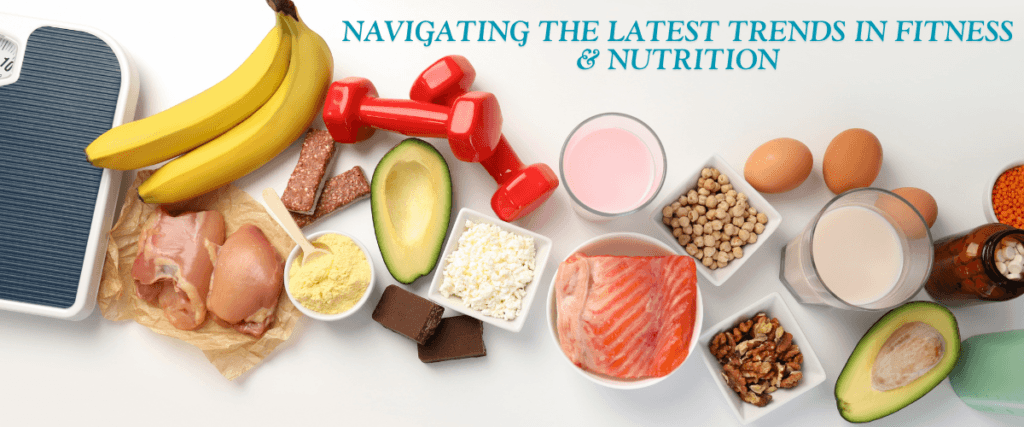The fitness and nutrition landscape is continuously changing, adapting to fresh scientific breakthroughs, technical innovations, and changing cultural values. Gone are the days of one-size-fits-all approaches. Today, the emphasis is on personalized, holistic well-being, focusing on sustainable habits and mindful practices. So, let me take you through the trends shaping the future of our health.
Fitness Trends: Beyond the Burn
- Personalized Training and Wearable Tech Integration:
- The era of generic workout routines is fading. Wearable technology(gadgets), such as fitness trackers and smartwatches, offer real-time information on heart rate variability, sleep patterns, and activity levels. Trainers and fitness apps then use this data to create personalized workout plans tailored to individual needs and goals.
- AI-powered fitness apps are becoming increasingly sophisticated, offering adaptive training programs that adjust based on performance and feedback.
- This trend emphasizes data-driven decision-making, allowing individuals to improve and enhance their workouts and track their progress with unprecedented accuracy.
- Functional Fitness and Movement as Medicine:
- The focus is shifting from isolated muscle training to functional movements that mimic everyday activities. This approach emphasizes strength, stability, and mobility, improving overall performance and diminishing the risk of injuries.
- Practices like mobility training, callisthenics, and primal movement are gaining popularity, promoting natural movement patterns and enhancing body awareness.
- “Movement as medicine” highlights the therapeutic benefits of exercise, recognizing its role in managing chronic conditions, improving mental health, and enhancing overall well-being.
- Hybrid Fitness and Boutique Studios:
- The rise of hybrid fitness combines elements of different workout styles, offering diverse and engaging experiences.
- Boutique fitness studios specializing in specific modalities, such as Pilates, barre, or HIIT, are gaining traction. These studios provide a sense of community and personalized attention, fostering a supportive environment.
- Online fitness platforms also offer hybrid models, combining on-demand workouts with live virtual classes, providing flexibility and convenience.
- Recovery and Regeneration:
- Recognizing the importance of rest and recovery, fitness enthusiasts are prioritizing practices like foam rolling, massage therapy, and cryotherapy.
- Sleep optimization is also a key component of recovery, with individuals focusing on improving sleep quality and duration.
- Active recovery, such as light stretching or yoga, is incorporated into training schedules to promote muscle repair and reduce soreness.
- Outdoor and Nature-Based Fitness:
- Connecting with nature is becoming an integral part of fitness routines. Outdoor activities like hiking, trail running, and paddleboarding are gaining popularity.
- “Forest bathing” and other nature-based practices are recognized for their stress-reducing and mood-boosting benefits.
- This trend emphasizes the importance of physical activity in natural environments, promoting both physical and mental well-being.
Nutrition Trends: Nourishing from Within
- Personalized Nutrition and Gut Health:
- The understanding that “one size fits all” doesn’t apply to nutrition is growing. Genetic testing and gut microbiome analysis provide insights into individuals’ dietary needs and sensitivities.
- Focusing on gut health is paramount, with an emphasis on consuming prebiotic and probiotic-rich foods, fermented foods, and fibre.
- This trend highlights the importance of personalized dietary approaches, optimizing nutrient intake for individual needs.
- Plant-Based and Flexitarian Diets:
- The popularity of plant-based and flexitarian diets continues to rise, driven by concerns about health, sustainability, and animal welfare.
- Emphasis on whole, unprocessed plant foods, including fruits, vegetables, legumes, and whole grains.
- The rise of high-quality plant-based meat alternatives has made flexitarian diets easier to manage.
- Mindful Eating and Intuitive Eating:
- Mindful eating motivates paying attention to hunger and fullness cues, savouring meals, and cultivating a positive relationship with food.
- Intuitive eating emphasizes trusting internal signals and rejecting restrictive diets.
- These practices encourage a healthy and balanced approach to eating, reducing stress and fostering body positivity.
- Functional Foods and Supplements:
- Functional foods enriched with specific nutrients or bioactive compounds are gaining popularity.
- Supplements, such as vitamin D, omega-3 fatty acids, and probiotics, are being used to address specific nutritional needs.
- People are becoming more educated on the benefits of things like adaptogens and nootropics.
- Sustainable and Locally Sourced Foods:
- Growing knowledge of the environmental impact of food production is driving a shift towards sustainable and locally sourced foods.
- Emphasis on reducing food waste, supporting local farmers, and choosing environmentally friendly products.
- This trend promotes a holistic approach to nutrition, considering both personal and planetary health.
Conclusion
The newest trends in fitness and nutrition highlight a move towards more individualized, holistic, and eco-friendly solutions. These shifts are being driven by technology, innovations in science and an increasing acknowledgement of the link between mental and physical health. All of these trends allow us to optimize our health, boost performance, and create connections with our bodies. The importance of listening to your body and understanding that trends are not always for every person is paramount.
Disclaimer
This blog is for general information purposes only and is not intended to provide nutritional or medical advice. Always confer with a registered dietitian or qualified healthcare professional before making any changes to your diet or exercise routine, especially if you have any underlying health conditions. The information provided in this blog post is based on current trends and research, which may evolve over time. Individual results may vary. The author is not liable for any consequences or adverse effects resulting from the use of the information provided in this blog.


